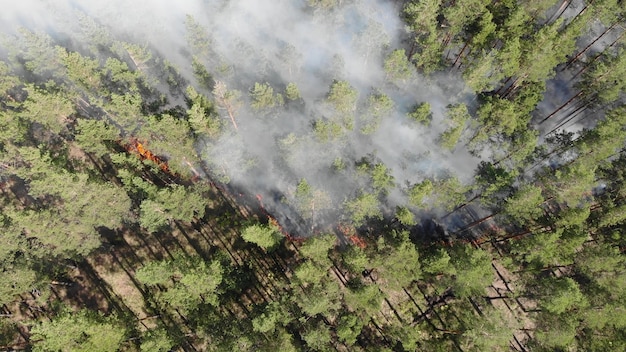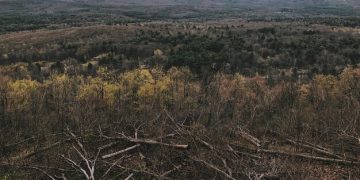Nature’s Resilience: Adapting US Forests to 1.5°C Rise

Nature’s Resilience: How Are US Forests Adapting to the Predicted 1.5 Degree Celsius Temperature Rise? explores the strategies and challenges facing American forests as they respond to increasing temperatures, including species migration, altered fire regimes, and the vital role of forest management.
The resilience of nature is constantly tested, and perhaps nowhere is this more evident than in the vast forests of the United States. Today, we will address Nature’s Resilience: How Are US Forests Adapting to the Predicted 1.5 Degree Celsius Temperature Rise?, examining their ability to adapt to the predicted 1.5-degree Celsius temperature rise, a critical threshold with far-reaching implications.
Understanding the 1.5°C Threshold and Its Impact on US Forests
The 1.5°C threshold, set by the Paris Agreement, represents a critical warming limit aimed at averting the most catastrophic consequences of climate change. For US forests, exceeding this threshold means more than just warmer temperatures. It triggers a cascade of ecological changes that threaten their health, composition, and ability to provide essential ecosystem services.
Understanding this threshold is crucial for grasping the urgency of forest adaptation strategies. Rising temperatures directly impact tree physiology, increasing stress levels and making them more susceptible to pests and diseases. The indirect impacts are equally significant, altering precipitation patterns, extending growing seasons, and intensifying wildfire risks.
The Direct Effects of Temperature Increase
Rising temperatures have profound effects on tree physiology. Photosynthesis, respiration, and water uptake are all influenced, potentially leading to reduced growth rates and increased mortality.
Altered Precipitation Patterns
Changes in precipitation patterns can disrupt soil moisture levels, affecting tree health and survival. Some regions may experience more frequent droughts, while others may face increased flooding.
- Increased tree mortality rates due to heat stress and drought.
- Shifts in species distribution as some trees are unable to tolerate warmer conditions.
- Increased vulnerability to invasive species and pathogens.
- Altered carbon sequestration capacity, impacting the forest’s role in mitigating climate change.
Ultimately, understanding the direct and indirect impacts of the 1.5°C threshold on US forests is essential for developing effective adaptation strategies. This includes proactive measures to enhance forest resilience, such as promoting biodiversity, managing forest density, and implementing targeted interventions to protect vulnerable species. By recognizing the challenges and embracing innovative solutions, we can ensure that these vital ecosystems continue to thrive in a changing world.

Species Migration and Range Shifts in US Forests
As temperatures rise, many tree species find themselves living in climates that are no longer suitable. In response, they attempt to migrate, shifting their ranges to cooler, wetter areas. This process, known as species migration or range shift, is a natural adaptation strategy, but it faces significant challenges in a rapidly changing world.
Understanding the dynamics of species migration is essential for predicting the future composition of US forests. Some species may be able to keep pace with climate change, while others may lag behind, leading to novel ecosystems with unpredictable consequences.
Challenges of Species Migration
Several factors can limit the ability of tree species to migrate effectively. These include habitat fragmentation, dispersal limitations, and competition from existing vegetation.
Assisted Migration as an Intervention Strategy
Assisted migration, or managed relocation, involves actively moving tree species to areas where they are projected to thrive in the future climate. This controversial strategy aims to overcome the limitations of natural migration, but it also carries risks associated with introducing species to new environments.
- Habitat fragmentation restricts the ability of species to move across the landscape.
- Dispersal limitations, such as seed weight and wind patterns, can slow down migration rates.
- Competition from existing vegetation can prevent newly arriving species from establishing themselves.
- Changes in soil types and nutrient availability.
The success of species migration and range shifts depends on a combination of natural processes and human interventions. By understanding the challenges and embracing strategies like assisted migration, we can help ensure that US forests remain diverse and resilient in the face of climate change. It is important to carefully consider the ecological and ethical implications of such interventions, striving to minimize unintended consequences and maximize the long-term benefits for both the forests and the communities that depend on them.
The Impact of Altered Fire Regimes on Forest Ecosystems
Climate change significantly alters fire regimes, leading to more frequent, intense, and widespread wildfires. These changes have profound impacts on forest ecosystems, affecting everything from species composition and carbon storage to air quality and human safety. Understanding these altered fire regimes is crucial for developing effective forest management strategies that mitigate the risks and promote resilience.
Changes in temperature, humidity, and wind patterns create conditions ripe for wildfires. Extended droughts and longer growing seasons exacerbate the problem, drying out vegetation and increasing the amount of fuel available for combustion.
The Ecological Role of Fire
Fire is a natural and necessary part of many forest ecosystems. It plays a crucial role in nutrient cycling, seed dispersal, and the creation of habitat for certain species.
The Risks of Intense Wildfires
While fire can be beneficial, intense wildfires can have devastating consequences. They can destroy mature trees, release large amounts of carbon into the atmosphere, and cause significant damage to property and infrastructure.
- Changes in forest structure and composition.
- Increased carbon emissions and reduced carbon storage capacity.
- Loss of habitat for wildlife.
- Threats to human health and safety.
Effective forest management strategies are essential for mitigating the risks associated with altered fire regimes. This includes prescribed burns, thinning operations, and the creation of firebreaks. By understanding the ecological role of fire and implementing targeted interventions, we can help promote forest resilience and protect both the environment and human communities from the destructive impacts of wildfires.

Forest Management Strategies for Enhancing Resilience
Given the challenges posed by climate change, proactive forest management strategies are essential for enhancing the resilience of US forests. These strategies aim to reduce vulnerability to climate-related stressors, promote biodiversity, and maintain essential ecosystem services.
A variety of forest management techniques can be employed to enhance resilience. These include thinning, prescribed burning, and the promotion of diverse tree species.
Thinning and Prescribed Burning
Thinning involves removing some trees from a forest stand, reducing competition for resources and making the remaining trees more resilient to drought and pests. Prescribed burning, as mentioned earlier, is the controlled application of fire to reduce fuel loads and promote ecosystem health.
Promoting Biodiversity
Biodiversity is a key factor in forest resilience. Diverse forests are better able to withstand climate-related disturbances and adapt to changing conditions.
- Reducing competition for resources by thinning overcrowded stands.
- Promoting diverse age classes and tree species.
- Protecting and restoring riparian areas and other sensitive habitats.
- Implementing best management practices for timber harvesting and road construction.
Effective forest management requires a holistic approach that considers the specific ecological context and management objectives. By implementing targeted interventions and adapting management practices to changing conditions, we can help ensure that US forests remain healthy, resilient, and capable of providing essential ecosystem services for generations to come. This includes ongoing monitoring and assessment of forest health, as well as collaboration among stakeholders, including government agencies, private landowners, and local communities.
The Role of Technology and Innovation in Forest Adaptation
Technology and innovation play a crucial role in enhancing the ability of US forests to adapt to climate change. From advanced monitoring systems to innovative silvicultural techniques, technology offers new tools and approaches for understanding and managing forest ecosystems.
Remote sensing, data analytics, and genetic engineering are just a few examples of how technology is being used to improve forest adaptation efforts.
Remote Sensing and Data Analytics
Remote sensing technologies, such as satellite imagery and LiDAR, allow scientists to monitor forest health and identify areas that are vulnerable to climate change. Data analytics tools can be used to analyze large datasets and identify patterns and trends that would otherwise be impossible to detect.
Genetic Engineering
Genetic engineering offers the potential to develop tree species that are more resistant to drought, pests, and other climate-related stressors. This technology is still in its early stages, but it holds significant promise for enhancing forest resilience.
- Improved data collection and analysis through remote sensing and data analytics.
- Development of drought- and pest-resistant tree species through genetic engineering.
- More efficient and targeted forest management practices.
- Enhanced monitoring of forest health and ecosystem services.
By embracing technological advancements and fostering innovation, we can significantly enhance the ability of US forests to adapt to climate change. This requires ongoing investment in research and development, as well as collaboration among scientists, policymakers, and industry leaders. By working together, we can harness the power of technology to protect and enhance these vital ecosystems.
Community Engagement and Education for Forest Conservation
Effective forest conservation requires the active engagement and support of local communities. Educating the public about the importance of forest ecosystems and the challenges they face is essential for fostering a sense of stewardship and promoting sustainable practices.
Community-based conservation initiatives empower local residents to become actively involved in forest management and protection. These initiatives can take many forms, from volunteer tree planting to citizen science projects.
The Importance of Education
Education is a cornerstone of forest conservation. By increasing public awareness of the value of forests and the threats they face, we can inspire individuals to take action and support conservation efforts.
Community-Based Conservation Initiatives
Community-based conservation initiatives offer a powerful way to engage local residents in forest management. These initiatives can empower communities to protect and restore their forests, while also providing economic benefits.
- Increased public awareness of the value of forest ecosystems.
- Empowerment of local communities to participate in forest management.
- Promotion of sustainable forest practices.
- Strengthening of the connection between people and nature.
By fostering community engagement and investing in education, we can create a culture of stewardship that supports long-term forest conservation. This requires collaboration among government agencies, non-profit organizations, and local communities. By working together, we can ensure that US forests are valued, protected, and sustainably managed for the benefit of all.
| Key Aspect | Brief Explanation |
|---|---|
| 🌡️ Temperature Rise | 1.5°C threshold impacts tree physiology and intensifies wildfires. |
| 🌲 Species Migration | Trees shift ranges but face habitat fragmentation. Assisted migration is considered. |
| 🔥 Fire Regimes | Altered patterns lead to more intense wildfires, affecting ecosystems. |
| 🌱 Forest Management | Strategies include thinning and promoting biodiversity for resilience. |
What is the predicted impact of a 1.5°C temperature rise on US forests?
▼
A 1.5°C temperature rise is predicted to cause significant changes in US forests, including increased tree mortality, shifts in species distribution, and a higher risk of wildfires due to drier conditions.
▼
Strategies such as promoting biodiversity, managing forest density through thinning, and implementing assisted migration can help forests adapt to climate changes. These actions enhance resilience and support survival.
▼
Altered fire regimes lead to more frequent and intense wildfires, which can destroy mature trees, release carbon, and alter habitat. Controlled burns and fuel reduction are critical to reduce these risks.
▼
Technological innovations like remote sensing, data analytics, and genetic engineering are being used to monitor forest health, analyze large datasets, and develop trees more resistant to climate-related stressors.
▼
Community engagement is vital because it fosters stewardship and supports sustainable practices. Local communities play a critical role in forest management and protection through various conservation initiatives.
Conclusion
The resilience of US forests in the face of a 1.5°C temperature rise hinges on a multi-faceted approach that integrates proactive management strategies, technological innovations, and community engagement. By understanding the challenges and embracing innovative solutions, we can help ensure these vital ecosystems continue to thrive, providing essential services and supporting biodiversity for generations to come.





